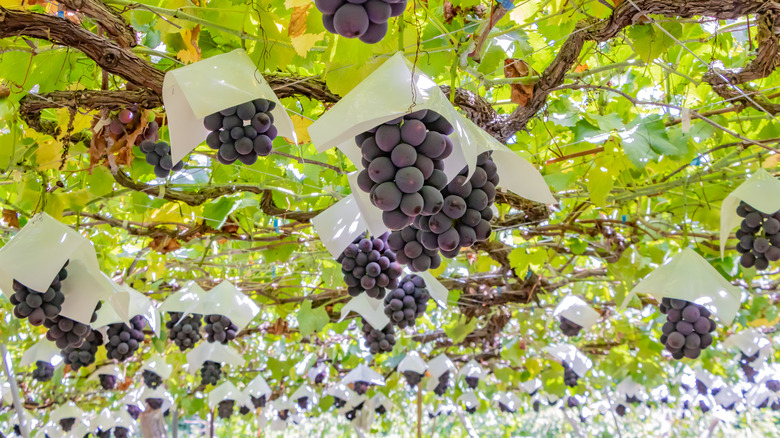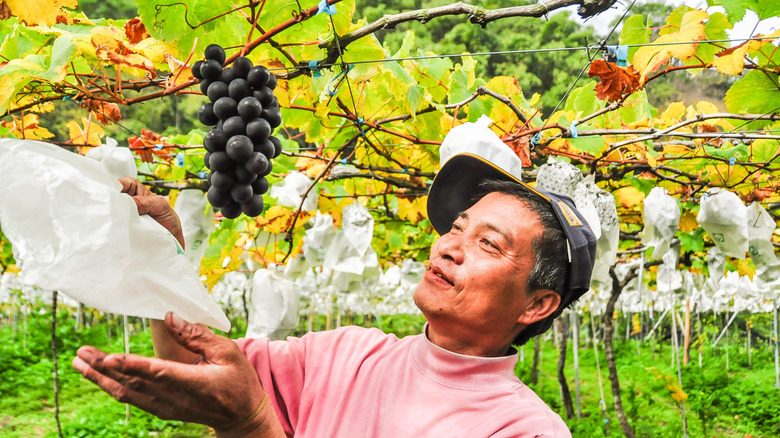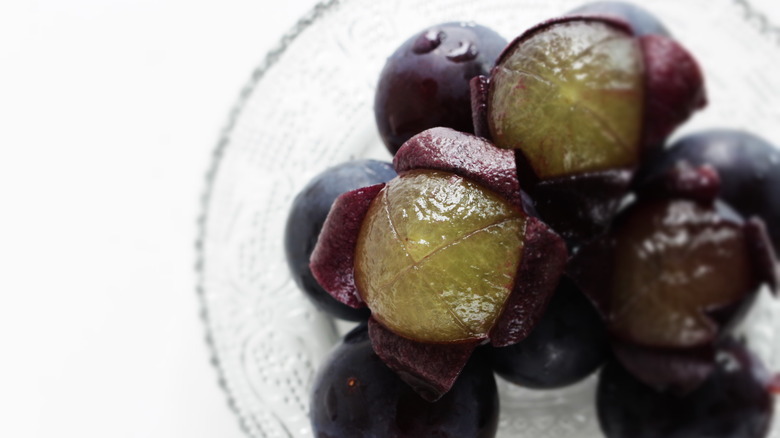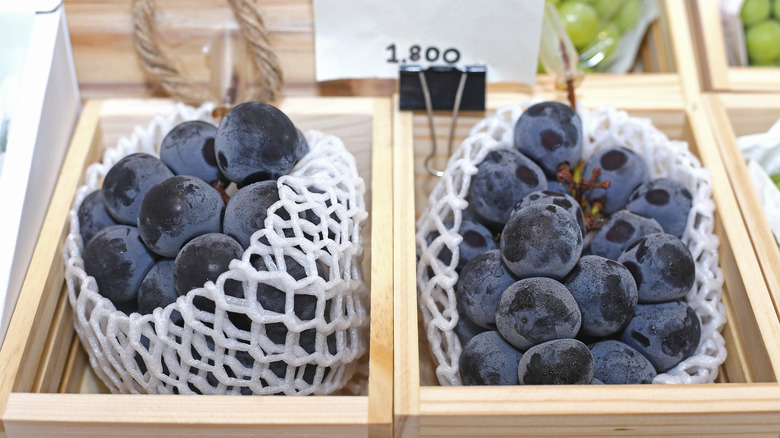The Japanese Grape Variety Named In Honor Of Mt. Fuji
A cross between two species of the Vitis genus, Kyoho grapes are famous for their size, appearance, and exceptional flavor. As of 2017, the International Organization of Vine and Wine reported that the large, flavorful grapes were the most widely grown variety in the world — but since production is limited to a few countries, they're virtually unknown outside of Asia.
While 90% of Kyoho grapes are grown in China, the fruit has special significance in Japan, its place of origin. There, Kyoho grapes are grown to careful specifications and fetch high prices in the country's luxury fruit market. A bunch of Kyoho grapes can sell for $60 or more, especially at the start of the season when demand is high.
Kyoho grapes aren't widely known in the United States, but they're gaining popularity thanks to viral videos. Tiktoker @kenapeay received hundreds of thousands of likes on a video where she raved about a box she bought for $80, and candies made from Kyoho grape jelly earned ASMR and mukbang influencers millions of views. But what's all the fuss about?
What are Kyoho grapes?
In 1937, Yasushi Oinoue of Shizuoka, Japan's Institute for Agronomical and Biological Science began work on a cross between European Centennial grapes and American Ishiharawase grapes. Inspired by the majesty of Mount Fuji, Oinoue named the grape Kyoho, which translates to "great mountain peak." In 1942, commercial cultivation began.
It wasn't until the late 50s, in the wake of World War II, that they became widely available in Japan. After the austerity of the war, Japanese consumers craved fresh, flavorful fruit — and Kyoho grapes fit the bill.
Kyoho grapes have thick, dark skin and an exceptionally sweet flavor. Known for their size, Kyoho grapes weigh in at around 20 to 40 grams — around the size of a small plum. You might notice a powdery white bloom over the surface of the grapes: this naturally protects them from moisture loss. They're considered a table grape, a kind meant for food rather than wine.
How are Kyoho grapes grown?
Despite the popularity of Kyoho grapes in countries like China and Korea, they're strongly associated with Japan. There, growing Kyoho grapes is treated with the reverence of an art form.
Most of Japan's Kyoho grapes are produced in Yamanashi Prefecture, near the fruit's namesake Mount Fuji. The region's climate helps give the grapes their exceptionally sweet flavor. The climate is only one of the reasons why Yamanashi's grapes have achieved such widespread popularity, though. The farmers who tend to them deserve credit, too.
Japan's famous fruit industry is no accident: the perfect melons, strawberries, and grapes that sell for exorbitant prices are the result of months of meticulous work. Farmers carefully prune bunches of grapes so that they contain 30 to 35 grapes — too many, and they'll start to lose their flavor. The grapes are grown in paper bags to protect them from insects, and once they're ready to be harvested, each bunch is carefully hand-selected for uniform color and size. The care given to growing Kyoho grapes is one reason why they fetch such high prices.
You don't have to travel to Asia to find Kyoho grapes, though: they're grown in Chile and California, too. Kyoho grapes first came to California in the 1970s and first became available in the 1980s. California Kyoho grapes are slightly different from their Japanese counterparts, though: since they were originally grafted onto Thompson grapes, they tend to have a lighter color.
What do Kyoho grapes taste like?
Kyoho grapes are high in sugar and low in acid, which gives them their characteristically sweet taste. The flesh is tender, almost gelatinous, and full of juice. They are rich and flavorful, often likened to sweet wine or Concord grapes, the variety that lends its flavor to most commercially-produced grape juices and jams. That's no accident: Kyoho grapes were initially bred to taste like Concords.
While skins are bitter and not meant to be eaten, they're easy to remove: Kyoho grapes are a variety of slip-skin grape. As the name implies, the skins of slip-skin grapes slide off with a gentle squeeze. Kyoho grapes tend to have large seeds, too, so be ready to spit them out. While this might seem like a lot of work if you're used to the thin-skinned, seedless grapes sold at American grocery stores, the popularity of Kyoho grapes proves that they're worth the effort.
Kyoho grapes vs Shine Muscat grapes
Despite the widespread popularity of Kyoho grapes in Japan, a competitor has come onto the market in recent years: the Shine Muscat. Muscat grapes are one of the oldest varieties in the world, and they were among the first grapes imported to Japan after the country ended its isolation policy in the late 19th century. Shine Muscats are a new phenomenon, though. Developed in 1997 and released to the public in 2006, their rising popularity has proved a threat to Kyoho grapes.
Like Kyoho grapes, Shine Muscat grapes are large, flavorful table grapes that originated in Japan. That's where the similarities end, though: in contrast to the dark, near-black color of Kyoho grapes, Shine Muscat grapes are a vibrant green. Unlike Kyoho grapes, they're seedless, too, with thin, edible skins.
Partially thanks to the fact that the Shine Muscat variety is easier to eat, the newcomer is poised to overtake the popularity of Kyoho grapes. Nippon.com reports that farmers are growing fewer Kyoho grapes, while the land dedicated to Shine Muscat production increases by 20% per year. Shine Muscat grapes have proved popular abroad, too: despite attempts from the Japanese government to keep the exclusive rights to the variety, the grapes are now grown in China and Korea.
How to cook with Kyoho grapes
Thanks to their widespread popularity throughout Asia, inventive cooks have found near-infinite ways to cook with Kyoho grapes. A quick Google search will bring you thousands of results for cakes, sorbets, and cocktails. They're cooked into jams, jellies, and syrups, layered with yogurt in parfaits, and used in fruit sandwiches, a popular Japanese treat. Some recipes even suggest pairing Kyoho grapes with meat for an unusual, savory-sweet combination. They're distilled into wine, too — but if you prefer dry wine, be forewarned. Kyoho wine has a reputation for being syrupy-sweet.
Fans of ASMR may be familiar with the round balls of Kyoho grape jelly often seen in viral videos. While these are generally store-bought, you can DIY them with a mold and konjac powder. The popular jellies aren't the only candy featuring Kyoho grapes, though. Travel to Japan, and you'll find Kyoho-flavored Pocky, Kitkats, and Mentos.
Of course, you can consume Kyoho grapes raw, too. If you manage to get your hands on some, use them to level up your charcuterie board, add them to a fruit salad, or simply pluck them straight from the bunch. Just be sure to finish them quickly: they're best if eaten within three days.
Where to buy Kyoho grapes
If you find yourself in Japan during Kyoho season, you'll likely find the flavorful fruits at popular grocery chains like Marukai. Not afraid to drop a little extra cash? Step into Sembikiya. Founded in 1834, Sembikiya is Japan's oldest — and most luxurious — fruit shop. Even if they don't have Kyoho grapes in stock, you'll get a one-of-a-kind shopping experience and the chance to try other premium fruits, like the store's famous muskmelons. You'll find plentiful selections in other parts of Asia, too, so look for Kyoho grapes in China, Korea, and
While Kyoho grapes are sold in the United States, they're not as readily available as they are in countries like China or Japan. If you're lucky, you might be able to find them at your local grocery store during late summer and early fall when they're in season. If you can't find them in the produce section, you may have better luck at a specialty fruit store. Some retailers sell Kyoho grapes online, too.
Nutritional information about Kyoho grapes
According to Specialty Produce, Kyoho grapes are nutritious: they're a good source of vitamin K, potassium, and fiber. Kyoho grapes also contain anthocyanins, the same colorful compounds that give fruits and vegetables like plums, blueberries, eggplant, and currants their distinctive hue. Anthocyanins have numerous health benefits. According to Healthline, they're an excellent source of antioxidants. Antioxidants help reduce inflammation, which can increase your risk of illnesses like cancer and heart disease.
According to a study published in the journal Molecules, anthocyanins have the potential to help reduce the risk of cancer. Another study, published in the International Journal of Molecular Sciences, suggested that they could help improve cognitive performance and delay cognitive decline.
But that's not all: Healthline notes that minerals like potassium and vitamin K help promote bone health. There's evidence that they may help improve eye health, lower blood pressure, and reduce cholesterol, too.







